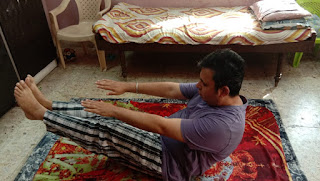Udana Vayu Mudra – How to do and its Benefits
 |
| Udana Vayu Mudra |
Yoga hand mudras are hand gestures which aim to balance the body elements by guiding the flow of prana (life energy) through the body. According to Yoga and Ayurved principles, the human body is made up of five elements fire, water, space and earth.
Udana Vayu is upward moving energy that administers the growth of the body like ability to stand, speak, think or make efforts. It is concentrated in chest area near diaphragm and throat.
During practice of hand mudra one or more fingers touch the thumb. This completes a close electric circuit and the energy flows. This balances the elements represented by those fingers.
These five elements further constitute the three doshas i.e. vata, kapha and pitta. Hence, yoga hand mudras not only balance the body elements but the doshas as well.
How to do Udana Vayu Mudra
Touch tip of index finger, middle finger and ring finger to tip of the thumb. The little finger remains straight.
This mudra should be done with both hands in any posture sitting, standing, walking or lying. For best results it should be done everyday.
- Sit in an easy cross legged position.
- Keep your spine straight.
- Close your eyes.
- Breathe normally and practice this mudra.
- Start with 10 minutes a day. It can be practiced up to 45 minutes a day at a stretch or 3 set of 15 minutes each.
Benefits of Udana Vayu Mudra
Udana Vayu Mudra is also known as Laughter Mudra or Hansi Mudra.
- Udana Vayu Mudra has therapeutic benefits for our brain, throat and respiratory organs. It provides smooth flow of blood to the brain and controls intellectual abilities like creativity, thinking, setting goals etc.
- It administers the respiratory organs and lets us breathe properly.
- This mudra optimizes brain and breathing. So this mudra promotes prosperity, wisdom, joy and laughter in our life. Hence, it is also known as laugther mudra.
- This mudra promotes self love and self acceptance. This mudra ensures smooth flow of udana vayu, which moves upward to open our heart and let us embrace ourself wholeheartedly.
- Udana Vayu Mudra promotes calmness. It relieves depression, stress and tension.
- It improves concentration, alertness and sharpens memory.
- It develops a positive attitude. It makes us happy and cheerful.
- It relieves pain, tension and discomfort in the throat.
- It also helps in various speech disorders. It aids in asthma, shallow breathing and other breathing difficulties.
This mudra resembles the face of swan, so it is also known as the Hansi Mudra.
Udana Vayu Mudra will bring positive results along with a healthy diet, positive lifestyle, exercise, proper sleep and stress free daily routine. It is not a replacement of a medical treatment.



Wish for you all blessings of life.
ReplyDeleteGood Wishes for everyone.
ReplyDelete